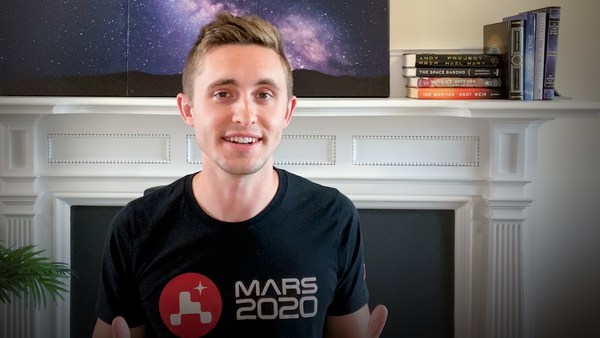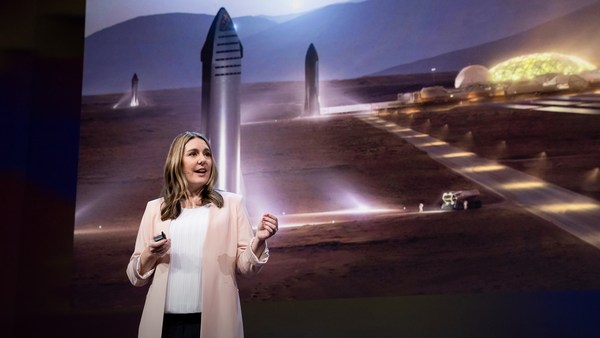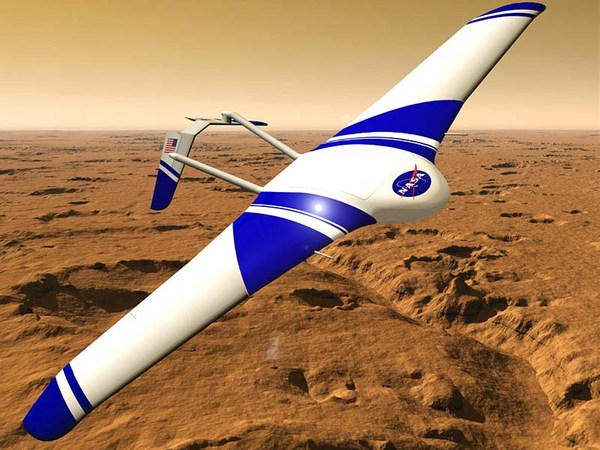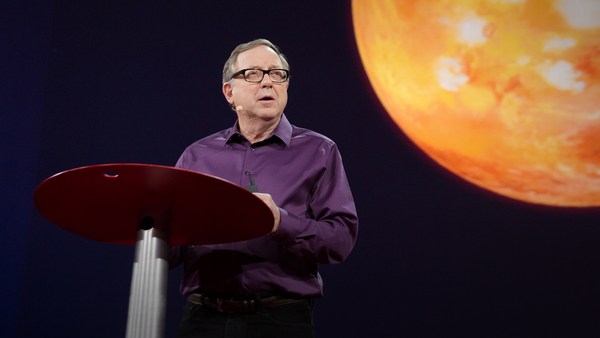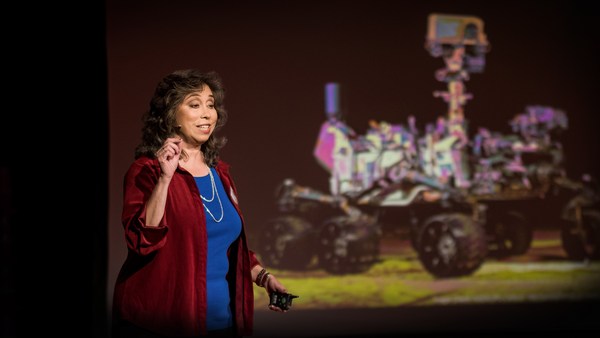When we think of space, we may think of the night sky, space suits, science fiction, space stations. With NASA's Artemis mission, we're going back to the Moon, for the first time in 50 years, and this time, with the first woman on the Moon. Woo-hoo.
(Cheers and applause)
You may also have heard that we're planning to send humans to the surface of Mars, and the logistics and rocketry for this long and arduous mission are going to be figured out eventually, but shockingly, one of the big problems we don't have a solution for is something that most people don't think about, and that is food. What are we going to feed the astronauts going to Mars? It turns out it's incredibly complicated.
Before we go there, I'd like to go over why I am here, talking to you about this. I am an industrial designer and an aerospace architect. I run a design firm called Nonfiction, and what we do is that we take science fiction and we make it real. It's a real job.
(Laughter)
Just to give you an idea of the type of work that we do, here are a few examples. We take technology and we make it a natural extension of the human body. We work with prominent neuroscientists and design wearables that help people fall asleep and stay asleep all night. We design batteries, low-cost, for rural Africa. We build schools that support neurodiversity and lifelong learning. We turn humans into superhumans.
So as you can see, I love working on projects that make the world a better place through design. But most importantly, I love food. I've been told that food is my love language. When I like someone, I feed them. When I don't like someone ... well, there's always pizza.
(Laughter)
So when I found out about this space food competition put together by NASA, the Canadian Space Agency and the Methuselah Foundation, I knew I had to be part of it. It's called the Deep Space Food Challenge. The premise of the challenge is to figure out what and how we're going to feed astronauts on their way to a deep-space mission, like going to Mars.
So sending living and breathing humans to Mars or a deep-space mission is very tricky, as you can imagine. Going to Mars is going to be extremely dangerous. The round trip is going to last two and a half to three years. The whole time, we're going to be bombarded with life-threatening levels of space radiation and we're going to float in microgravity or stand on the surface of Mars, experiencing one-third of Earth's gravity. So it's really uncomfortable to be up there. And so all of these conditions, on top of isolation and stress, are going to make it very hard for astronauts to keep their weight and their health at optimal levels. And one of the main culprits of them losing their weight is actually unappetizing food.
So imagine having to eat things like these for three years straight, right? And looking at the same five people. That's going to be really hard.
(Laughter)
So what I'd like to go over is what astronauts eat aboard the International Space Station, for example, right now. So essentially, they have access to ready-to-eat food, or food, or freeze-dried food that you see here, that's rehydrated with water. And so it's either goop in a bag, or if you're feeling fancy, you can place that goop in a space tortilla.
(Laughter)
So tortilla is actually very popular in space, because it satisfies like bread, but doesn't crumble and clog the air-filtration system. Now, the quality of that tortilla would make your Mexican grandmother roll over in her grave, but it's better than nothing.
By the way, the water that rehydrated the freeze-dried food is recycled again and again. We don't have the luxury to send all the water that we need. There's no romantic way of saying it -- it's filtered gray water and pee. Ew ...
Every once in a while, astronauts aboard the ISS have access to fresh produce and that comes from resupply rockets. This happens because the Earth is only 250 miles from the ... space station. And that's not going to be an option for people going to Mars, because that's 300 million miles away, one way. They're not going to send, like, a small rocket with apples and oranges, just for you.
(Laughter)
So going to Mars is going to be very hard. It's like hardcore backpacking in the wild, except the wild is a cramped space surrounded by things that can kill you at any moment.
(Laughter)
So packing food for Mars is going to require one ton per person per year. So if we have a crew of five, six astronauts, that’s a lot of weight. And if there’s one thing you need to learn about space is that weight is money.
So what my design team came up with is this amazing system called the Space Culinary Lab. By the way, we won the first phase of this competition, and are currently working on prototypes.
(Cheers and applause)
So let's go over the four sections of this machine. Step one -- coffee. In the morning, it's nice to have a rich, creamy, hot beverage. A nutritious version of this is butter coffee. What would it take for astronauts to make space butter coffee? So one of our team members created this mechanical homogenizer that breaks down coffee granules, hot water, collagen and ghee together and creates this unctuous, satisfying mouthfeel solution that is really nice to drink. What's nice as well is that it provides you with omega-3 fatty acids that can protect your brain and your heart, as well as reduce inflammation.
Step two -- snacks. Microalgae, like spirulina: research in animals has shown that it can also boost your immune system, and help your body from developing cancer. But the problem is algae is gross.
(Laughter)
It smells funny and it doesn't taste that great. So what we can do is to cultivate a fresh batch aboard the spaceship, dehydrate the microalgae, and then mix it with other ingredients. We can mix it with oats, with nuts, with powdered berries, with spices. We can make them sweet, sour, savory, spicy, whatever your heart desires.
Oh, and as a bonus, growing microalgae absorbs carbon dioxide from the air and produces oxygen. In other terms, it's carbon-negative. So now imagine all of the food systems that we have on the surface of the Earth. What if producing food actually reversed climate change? Wouldn't that be cool?
Step three -- salad. When astronauts go on long missions to space, one of the things they look forward to the most when they come back to Earth is the crunch of a salad. So salads were designed to grow with gravity, so now we're asking it to grow without gravity. Well, thankfully, the International Space Station experiments have proven that we can do that with lettuce, with kale and with other greens. Let’s give our Mars explorers a space garden. It's great to give them some fresh produce to eat once in a while and it's nice for their mental health to look at a garden once in a while.
Last but not least, step four -- space barbecue.
(Laughter)
So a lot of cultures all over the world consider grilled protein a meal centerpiece. Unfortunately, open fire is frowned upon in space.
(Laughter)
So we're going to use lasers. So we're going to take a piece of chicken, for example, and we're going to rehydrate it with a carbohydrate solution. And then from there, we're going to design a grill pattern on top of the chicken, using lasers. And so the heat, carbohydrate and protein combination creates the signature caramelization that makes barbecued meat taste and smell so delicious.
With the Space Culinary Lab, we can imagine all the combinations of flavors, textures, colors and rituals, even, that can come out of this. What if a Michelin star chef had access to this kind of system and created their own spaceborne dishes? Like, think astrobisque, floating space-juice caviar, or space whiskey.
(Laughter)
What is traditionally called a galley or prep station is now something that looks and feels a lot more like a farm-to-table kitchen, but in space. What we want to do, really, is to take all of that space innovation and bring it back to other places in space. We're going to go to the Moon, we're going to go to Mars, and what we really want to do at the end is make space more human. We want to apply this to all life-support systems up there.
And bringing all of that technology back to Earth is nothing new, by the way. Like, we've been using a lot of technologies, every day, that were invented in space. For example, solar cells, prosthetics, water filtration systems, GPS, wireless communication devices, even the lens on your camera phone.
So, you know, when we think about taking all of that technology that we're developing in space, what we want to do, really, is create regenerative ways to replace nonregenerative agricultural methods that demand too much resources on Earth. Every day, there's a lot of space innovation that's happening, space that's here to benefit us on Earth. So one day, not so far in the future, maybe the way we create food in space will help us open the door to become a sustainable interplanetary species.
Thank you.
(Cheers and applause)

